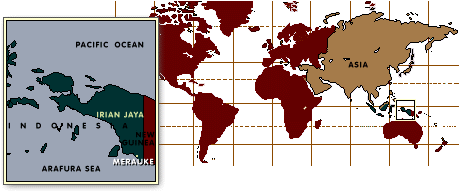
Wasur National Park

Project Background:
Irian Jaya contains some of the best, most extensive and least disturbed wetland areas in the Asia/Pacific region. Wasur National Park (NP) in south-east Irian Jaya covers some 413,810 ha, all of which have already been gazetted, including 10,400ha of open water swampland (Rawa Biru) in the centre of the park. The reserve is located in the driest part of the province and contains a diversity of lowland habitats, including MelaleucaEucalyptus woodlands, savannas, swamps, mangrove, lowland forest, and vast tidal mudflats. Its avifauna is one of the richest in Irian Jaya, with an estimated 390 species that include huge populations of migratory Palaearctic waders and breeding and migratory waterfowl from Australia. There are about 80 mammal species in the reserve, including the exotic rusa deer and wallabies.
The park lies in the administrative district of Merauke, which has the country's highest annual population growth and density. The region has 45% of the province's potential agricultural land and pressure will therefore continue growing. About 2,550 people live in 14 villages in the reserve, and largely depend on the park and its wildlife for their livelihood. These people are intimately linked to their land and this relationship is basic to the structure of their society. During the sixmonth dry season, the park becomes the most accessible PA in Irian Jaya's entire terrestrial reserve system. At this time it suffers from nontraditional poaching, burning, cutting of trees, and other disturbances to wildlife. As a result, at the time this project was started, the park was threatened by human population expansion and by growing levels of encroachment, such as sand poaching. Uncontrolled hunting and poaching was seriously depleting the park's wildlife and degrading previously undisturbed environments. As a result of the project's activities, there has been a major turnaround in the area, with local tribal people being granted sustainable use rights in the park in exchange for their active participation in its protection. Some poachers and other exploiters have been evicted from the park, whilst the local and provincial government have made strong commitments to ensuring the future integrity of the park. The current challenge is to consolidate these gains, and to put park protection on a longterm sustainable basis.
Quoted from WWF International Database
Copyright © 2000 Conservation Science WWF Indonesia-Sahul Bioregion